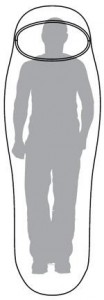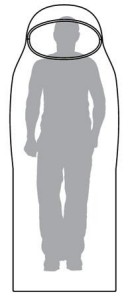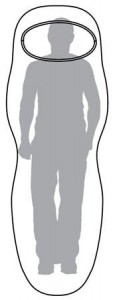The first recommendation is to be clear about the use that we are going to give it and then choose a sleeping bag that adapts to the type of use without sin of buying a bag with little insulation being able to go cold during the break or with too much insulation and have heat. Another aspect to keep in mind is that the sacs do not create heat, they only prevent the loss of body heat.
Fill types
There are two types of filling in sleeping bags, fiber or synthetic fabrics and bird feather. The main difference in a very summarized way would be that synthetics facilitate maintenance and that the pen provides the highest quality insulation.
Temperatures of use
The temperatures of use that we collect are based on the EN 13537 standard that is currently the only European regulation that guarantees a methodology and a standard. The definitions of each temperature included in the regulations are comfort, limit and extreme.
Limit temperature
It’s the temperature at which a sleeper can sleep inside the sack without sweating. It is measured with the zipper open, arms out and hood open. The measurement is carried out with a man of 25 years, 70 kg and 1.73 m high.
Comfort temperature
Temperature in which a 25-year-old woman, weighing 60 kg and 1.60 m tall, can sleep in the foetal position without going cold. Or a half-sleeping man in a relaxed position. It is the temperature to consider at the time of purchase.
Extreme temperature
At this temperature the sac protects against hypothermia. Allowing a standard woman with a feeling of cold to a maximum of 6 hours of sleep in the fetal position.
Aspects that influence thermal sensation
Every person is a world. This phrase is also extrapolated to the thermal sensation. There are people who are colder and hotr. Below are aspects that influence each person’s feeling of cold as well as outdoor conditions that also affect.
Physical aspects
Heat loss from within the sac is due to conduction or by direct contact with the ground or various other means. For example, radiation is loss through direct heat contact, this effect increases with wind. The more weight of the sleeper the more the sac is compressed and the losses are greater as there is greater contact with the ground. To reduce this loss it is convenient to use mats that dampen the weight of the sleeper. Another means of temperature loss is evaporation. Sweat is a bodily effect to regulate temperature and is effective if moisture is able to leave the sac, other than this will get wet and cause discomfort for the sleeper. It will also cause the bag to lose its thermal characteristics being more problematic this aspect in the feather sacs as they absorb more moisture than synthetic ones.
Physiological aspects
The temperature generated by our body also depends on physiological factors. Body heat loss depends on each person’s metabolism and greatly influences their body weight. For reference it can be taken that a person of 50 kg generates 60 watts of heat. While a 110 kg person generates 100 watts.
Slim or wide
People with more fat have a higher insulation capacity. People with higher muscle mass also generate more heat. Thinner people tend to generate less heat.
Gender
Women tend to have colder than men,being the difference of about 5 °C to reach the comfort temperature in the EN 13537 standard. This difference is usually due to muscle mass and body fat.
Age
The tendency with age is to generate fewer calories. Muscle mass with age also tends to decrease.
Preparation
People who are prepared and leave are usually tending to feel less cold. Also if a person is very tired it generates less heat than if they are more rested. Getting to know each other is very important because a person who knows himself will know how to warm up and with what to feel less cold.
Energy consumption before bedtime
The amount of energy generated during sleep depends on the activities performed during the day. For example, a person who has taken a quiet trek and eaten hot food will be in better condition than a climber who has made a great effort.
Types of construction
Mummy type

It is the most typical cut today, being wider at the top and narrower at the feet. This design is more efficient in heat retention since the amount of air inside the bag is less. It also weighs less and takes up less space than straight sacks because it requires less material.
Straight sacks

They’re the classic kind of sack. They have a zipper that allows the total opening of the bag and can be used as a blanket. This sack is conducive to the most restless people, as it provides greater freedom of movement for the legs. On the contrary, the heat retention is worse since there is more air inside and also weighs and takes up more space when it is collected.
Adapted mummy type
These sacs are more widened at chest and knee height providing greater mobility. These bags provide maximum comfort and optimal heat retention.
Types of internal construction
If the filling of a sleeping bag was unstructured, it would accumulate at some points and at others cold spots would be created. That is why the bags are made with different compartments. Partition separators can normally be H-shaped,the simplest segmentation. The partitions are H-shaped parallels thus preventing the fill from moving. Another type of separation is trapezoidal,whose shape prevents the displacement of the filling and also avoids cold spots without filling. As the partitions are not straight between the outside and the inside of the bag it is guaranteed that there will always be a layer of filling between the inside and the outside. Synthetically insulated bags can also be built in layers. If a sack is built in layers, two or more, each layer is overlapping maximizing thermal efficiency. An example would be a sack with three layers. Layers would work like this:
- A first inner layer that reflects body heat avoiding its loss.
- A second layer of fiber filling that keeps air between its cavities.
- Another layer that ensures heat retention of the entire structure.
Specific adaptations
Thermal collar
Its main function is to prevent heat loss. There are several types of collars depending on their use. Extreme collars are like a vest and minimize thermal loss. Lighter bags do not require them as the bags are not intended to withstand extreme temperatures, although some have a collar consisting of a padded layer that surrounds the neck providing support and reducing thermal loss. Normally the closure of the collars are by button, for easy opening and closing.
Hooded parafrio
Compartment designed for the size of a pillow approximately, allowing the pillow not to come out of the bag during sleep. It also provides insulation of the head from the outside.
Parafrio hood adjustment rubber
The hood size can be easily adjusted by using a user-based adjustment rubber and outside temperature.
3d standing section
The feet have a greater space to be able to move them, since the habitable volume in the lower area of the sacis increased. In addition, due to the special design the filling is less compressed so there is also a thermal improvement.
Foot compartment
Compartment specially created for the feet. This adaptation means that there is less air through a compartment, therefore a thermal improvement is achieved in addition to keeping the feet dry from the outside. Due to the lower amount of air, the thermal improvement and together with the use of socks, the improvement is sharpened.
Inner net pocket
Interior pockets that allow you to have at hand certain small and important elements.

We are also in